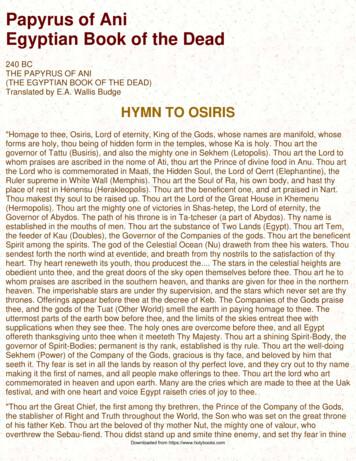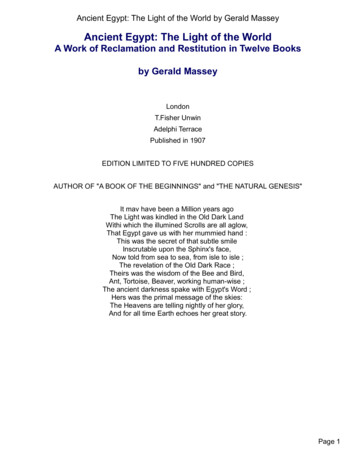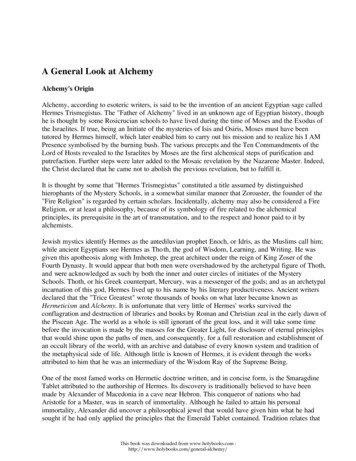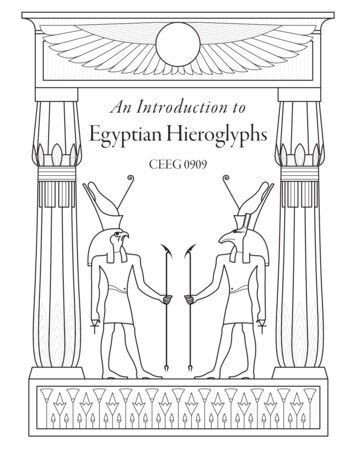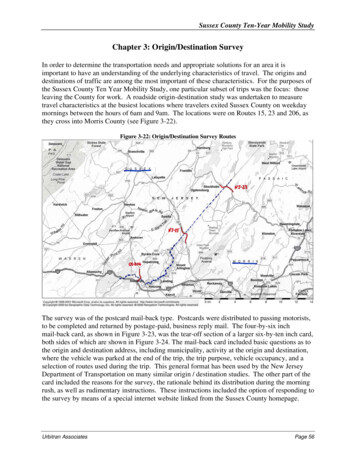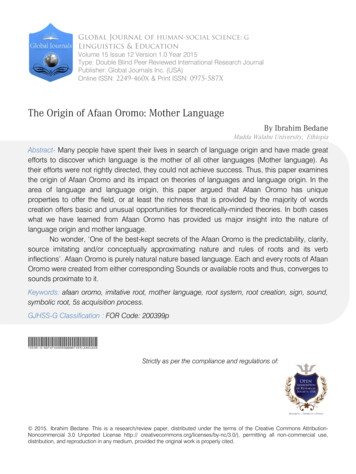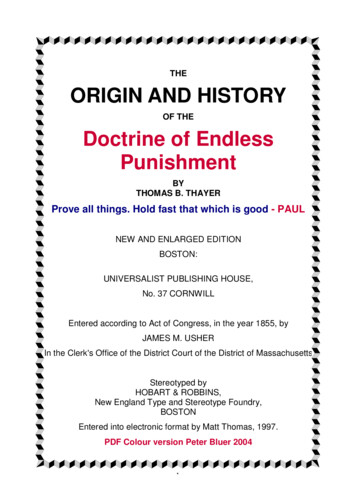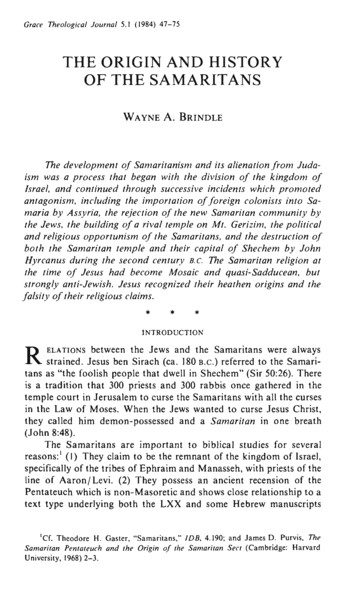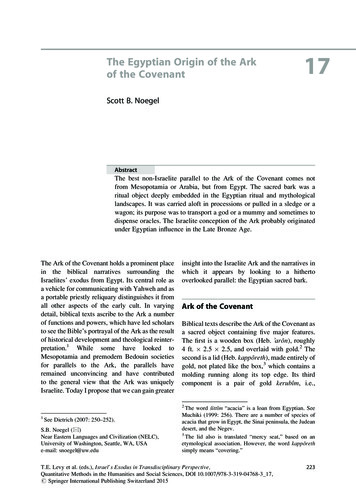
Transcription
The Egyptian Origin of the Arkof the Covenant17Scott B. NoegelAbstractThe best non-Israelite parallel to the Ark of the Covenant comes notfrom Mesopotamia or Arabia, but from Egypt. The sacred bark was aritual object deeply embedded in the Egyptian ritual and mythologicallandscapes. It was carried aloft in processions or pulled in a sledge or awagon; its purpose was to transport a god or a mummy and sometimes todispense oracles. The Israelite conception of the Ark probably originatedunder Egyptian influence in the Late Bronze Age.The Ark of the Covenant holds a prominent placein the biblical narratives surrounding theIsraelites’ exodus from Egypt. Its central role asa vehicle for communicating with Yahweh and asa portable priestly reliquary distinguishes it fromall other aspects of the early cult. In varyingdetail, biblical texts ascribe to the Ark a numberof functions and powers, which have led scholarsto see the Bible’s portrayal of the Ark as the resultof historical development and theological reinterpretation.1 While some have looked toMesopotamia and premodern Bedouin societiesfor parallels to the Ark, the parallels haveremained unconvincing and have contributedto the general view that the Ark was uniquelyIsraelite. Today I propose that we can gain greater1See Dietrich (2007: 250–252).S.B. Noegel (*)Near Eastern Languages and Civilization (NELC),University of Washington, Seattle, WA, USAe-mail: snoegel@uw.eduinsight into the Israelite Ark and the narratives inwhich it appears by looking to a hithertooverlooked parallel: the Egyptian sacred bark.Ark of the CovenantBiblical texts describe the Ark of the Covenant asa sacred object containing five major features.The first is a wooden box (Heb. ʾarōn), roughly4 ft. 2.5 2.5, and overlaid with gold.2 Thesecond is a lid (Heb. kappōreth), made entirely ofgold, not plated like the box,3 which contains amolding running along its top edge. Its thirdcomponent is a pair of gold kerubı̂m, i.e.,2The word šittı̂m “acacia” is a loan from Egyptian. SeeMuchiki (1999: 256). There are a number of species ofacacia that grow in Egypt, the Sinai peninsula, the Judeandesert, and the Negev.3The lid also is translated “mercy seat,” based on anetymological association. However, the word kappōrethsimply means “covering.”T.E. Levy et al. (eds.), Israel’s Exodus in Transdisciplinary Perspective,Quantitative Methods in the Humanities and Social Sciences, DOI 10.1007/978-3-319-04768-3 17,# Springer International Publishing Switzerland 2015223
224“sphinxes,”4 that rest on top of the lid and faceeach other with their wings touching. Note thatthe lid was understood as God’s “throne,”whereas the box was viewed as his “footstool”(e.g., 1 Chron 28:2, 2 Chron 9:18, Ps 99:5,132:7). The Ark’s fourth feature was its woodenpoles, which were inserted through four goldrings and never removed.5 Only the priestlytribe of Levi was permitted to carry the Ark,and even then, only after they had veiled it(Exod 40:3, 40:21).6 No one of non-priestlydescent was allowed to touch it. The Ark’s fifthfeature was its contents: the tablets of the law(Deut 10:1–5, ʾarōn hab-berı̂th; Exod 25:22,ʾarōn ha-edūth), a jar of manna (Exod16:33–34), and possibly the rod of Aaron (Heb9:4, cf. Num 17:10).74On the Egyptian origin of this creature, see alreadyAlbright (1938) and now Mettinger (1999). Attestationsof the Assyrian cognate dkurı̄bu do not permit a precise ora consistent description of the creature. Thus, someappear to have animal heads while others have humanheads. Nevertheless, the dkurı̄bu commonly are describedas fashioned images that either stand at entrances toportals or face each other. The use of the cuneiformDINGIR sign marks them as divine. See CAD K, 559, s.v. kurı̄bu. Even in the Bible, there is some variationconcerning this creature. Thus, the kerubı̂m on the Arkhave two wings (Exod 25:20, 37:9), but four wings inEzekiel’s vision (Ezek 1:6). The closest parallels are thesarcophagus of Ahiram, king of Byblos, and an ivoryfound at Megiddo. Both objects are highly Egyptianizedand depict a king seated on a kerubı̂m-flanked throne. Thelatter item also features a winged solar disk and lotusoffering. See Kyrieleis (1969: 41–81). Many objectsfound at Megiddo dating to this period evince Egyptianinfluence, if not also a presence. See Novacek (2011). Onother possible parallels, including a stone throne fromLebanon and a divine statue from Cyprus, see Zwickel(1999: 101–105). On archaeological evidence for theIsraelite cult, see Zwickel (1994).5On two occasions oxen pulled the Ark on a “newlyconstructed wagon” (1 Sam 6:7, 2 Sam 6:3), though thiswas not ordinary practice.6Moreover, the priests were forbidden from looking at thekappōreth “lid.” Hence, it was veiled. Only the high priestcould look at the kappōreth on Yom Kippur, provided hehas undertaken a special rite and has changed hisgarments (Lev 16:4). On the veil and the lid, see Bordreuil(2006).7According to Josephus, Jewish Wars 5.219, the innermost sanctum was empty.S.B. NoegelIn addition to serving as a reliquary, textsattribute two other functions to the Ark. Mostprominently, it served as the symbolic presenceof Yahweh. In times of war, Yahweh led as theLord of Hosts, seated upon the kerubı̂m,surrounded by standard bearers preceding him.Each standard was topped with a bannerrepresenting an Israelite tribe or family line(Num 2:1–34, 10:35, Ps 132:8).8As the symbolic presence of Yahweh, the Arkwas connected to miracles and oracles. Thus,when the priests carried the Ark into the JordanRiver the waters parted (Josh 3:8–17), andMoses, Phinehas, Samuel, Saul,9 and Davideach received divine direction from the Ark(Exod 25:22, 30:6, Num 7:89, Judg 20:27–28, 1Sam 3:3, 1 Sam 14:18, cf. 2 Sam 2:1, 5:19, 11:11,15:24).10Before the temple was built, the Ark stayed ata number of sanctuaries including Gilgal (Josh7:6), Shechem (Josh 8:33), Bokhim (Judg2:1–5), Bethel (Judg 20:27), Shiloh (1 Sam3:3), Kiriath-Jearim (1 Sam 7:1–2), and Gibeon(1 Kgs 3:4, 1 Chron 16:37–42, 21:29, 2 Chron1:3–4). During the visits Yahweh would acceptsacrifices and bless his sanctuaries. Finally, theArk acquired a ritual function. On Yom Kippurthe high priest would sprinkle bull’s blood ontoand in front of the Ark’s lid (Lev 16:14).8In Exod 17:15, Moses built an altar to Yahweh after hisbattle against the Amalekites and named it ְיהָו֥ה ִנִּֽס י “Yahweh is my banner.” The identification of Yahwehwith a banner is reminiscent of the Egyptian hieroglyphicrepresentation of ntr “god” with a banner (i.e., ).91 Chron 13:3 suggests that people did not seek oraclesfrom the Ark during Saul’s reign.10The LXX of 1 Sam 14:18 reads “ephod.” The instrument of divination in 2 Samuel is less clear, but Van derToorn and Houtman (1994) argue that “ephod” herestands for “Ark” and that the Ark functioned for divination. They also opine that there were multiple Arks in theregion whose existence was blurred by later Deuteronomist editing. If the authors are correct in arguing that theArk that David brought to Jerusalem was not a nationalsymbol, but a Saulide cult object, then perhaps we shouldlook to the tribe of Benjamin as the original locus for theobject.
17The Egyptian Origin of the Ark of the Covenant225Fig. 17.1 Divinepalanquins, relief ofTiglath Pileser IIIPreviously Proposed Parallelsto the ArkScholars have cited two objects as possibleparallels for the Ark. The first is a divine palanquin as seen notably in the Assyrian reliefs ofTilglath Pileser III (744–727 B.C.E.).11 Thepanel shows the king’s seizure of foreign godsfrom their temples (Fig. 17.1).12While some of the gods sit on thrones andmight have served as a source of oracles, a number of differences remain. No poles were used totransport them, and there are no boxes and nolids. They were not covered in gold, nor do any ofthem contain relics or kerubı̂m. There is no evidence that the statues were carried into battle.Finally, there appear to have been no restrictionson who could touch them.A second object previously compared to theArk is the Bedouin ʿut fa (also called a mahmal, abu-dhur, markab, and qubba [Fig. 17.2]).1311Zwickel (1999: 106) also suggests a parallel with Egyptian divine palanquins, but he appears to reject it, becausethe Bible refers to the ʾarōn as a footstool. He does notconsider a connection to the barks. See also Zwickel(1994).12The relief, which is on display in the British Museum,was photographed by the author.13The image of the ʿut fa appears in Musil (1928: 573). The ʿut fa, mahmal, abu-dhûr,markab, and qubba have been treated rather loosely as a collective by earlierbiblicists who proposed them as parallels to the Ark(e.g., Morgenstern 1942; de Vaux 1965: 9, 296–297),and since that time they have been adopted somewhatIt accompanied tribes into battle and signalledthe presence of the divine. However, the Bedouintransported them on horses or camels. Itcontained no box, no lid, and no poles. Somewere inscribed with spells and Quranic verses,but they never served as reliquaries or as thethrone and footstool of God. They were notoverlaid in gold, and they contained no kerubı̂m.There also were no restrictions on who couldtouch them.While the palanquin and Bedouin objectsoffer some parallels, the dissimilarities limittheir usefulness as analogues. Indeed, MenahamHaran long ago observed that the Ark’s originsmust be sought not in nomadic life, but in auncritically into the scholarly literature. Nevertheless,the items are rather distinct in appearance and function,and each has its own history. The ʿut fa generally refers tothe hooded camel saddle used by married women ofSudan, Arabia, Tripoli, etc. It cannot be traced to preIslamic times. See Robinson (1931b). Tradition places theorigin of the mahmal in Mamluk Cairo in the thirteenth century CE. See Robinson(1931a). The merkab and abudhûr appear to be synonyms for the ostrich-feather litterthat sits upon camels. They are recorded in premodernBedouin society, but not pre-Islamic society. See Musil(1928: 571–574). The Egyptian merkab cannot be datedbefore the eleventh century CE, when the Persian travelerNasir-i Khusrau described its use in conjunction with aNile inundation ceremony, see Sanders (1994: 103). Onlythe qubba dates to pre-Islamic times, as it is representedon the temple of Bel at Palmyra (first century CE). Nevertheless, all of these litters are tent-like structures, andthus, they are more fruitfully compared to the tabernacle.See Homan (2002: 90–94). Homan does not discuss theabu-dhur. The Hebrew cognate qubbāh in Num 25:8 alsorefers to a tent.
226S.B. NoegelFig. 17.2 Bedouin ut fa sedentary community, since the Israelite priestscarried it on foot (Haran 1985: 270). Moreover,as Michael Homan has shown (Homan 2002:113–114), the strongest parallels for the tabernacle in which the Ark was placed are ancientEgyptian military and funerary tents includingthe tent-like coverings for funerary barks.14This suggests even greater propriety in lookingto Egypt for an analogue.1514Curiously, Homan (2002: 113) does not discuss a possible parallel between the Ark and the Egyptian bark, butinstead he notes that Ramesses’ golden throne appears inthe Qadesh record as “flanked by falcon wings, just as theArk is flanked by winged cherubim.” Moreover, Homan(2002: 145–147) notes that the construction of thetabernacle’s frame employs the term qerāšı̂m “(thin)boards,” a word of nautical importance that elsewhere(i.e., Ezek 27:6) refers to the main cabin on a boat. Seealso Kitchen (1993: 119–129).15We may add to this the fact that biblical tales set inEgypt often show a close knowledge of Egyptianpractices and beliefs and, in some cases, draw upon Egyptian literary traditions. See, e.g., Sarna (1986) and theEgyptian Sacred BarksWith this in mind, I should like to propose thatthe Egyptian sacred bark offers a more compelling and complete parallel for the Ark. Of course,the bark was not merely a boat, but a sacred ritualobject deeply imbedded in the ritual and mythological landscapes of the Egyptians. Though theyresembled boats, they rarely, if ever, were set inwater. Even when they needed to cross the Nile,they were loaded onto barges. Usually, they werecarried by hand or in some cases dragged on asledge or placed on a wagon (Fig. 17.3).16The bark’s most basic function was to transport gods and mummies. When transportinggods, the bark was fitted with a gold-platednaos containing a divine image seated on a hwt brief discussion by Currid (1997: 23–32) and hisbibliography.16Photograph of sacred barks at Medinet Habu by theauthor.
17The Egyptian Origin of the Ark of the Covenant227Fig. 17.3 Barks on standswith carrying poles,Medinet Habublock throne,17 which was veiled with a thincanopy of wood or cloth (Fig. 17.4).18When transporting the dead, it carried thesarcophagus within a covered gold-plated catafalque (Fig. 17.5).19 There is no one type of17On the hwt-block throne, srh-block throne, and the see Kuhlmann (2008). “lion-throne,”For a comparativework on thrones, see Metzger (1985).18The veiled bark of Amun here comes from a relief atKarnak, photographed by the author.19The photograph of the bark transporting the catafalquein the tomb of Userhat (TT 56) was taken by the author.sacred bark, but rather many variations on atheme, each with its own set of accouchement.20Many barks were decorated with protectivekerubı̂m, such as the naos of the bark of Amun20See Göttlicher (1992: 13–75), who divides the culticbarks into four basic types: those belonging to districts,states, gods, or of non-locale or unspecified nature, witheach category containing many variations. Most of thebarks are given epithet-like names, though the generalterm for bark appears to have been wi3, perhaps relatedto the verb wi3 “to be separated, secluded, segregated.”See WÄS 1982: 272.
228S.B. NoegelFig. 17.4 Veiled bark ofAmun, Karnakfound on Seti I’s mortuary temple in Qurna(Fig. 17.6, left) and the bark of Horus in thetemple at Edfu (Fig. 17.6, right).21Like the Ark of the Covenant, sacred barkswere carried on poles by priests, the so-calledpure ones (Egyptian: wʿbw), who had performedpurification rituals in order to hoist the bark.Though most Egyptian rituals were neverwitnessed by the public, the procession of thesacred bark was an important exception. It wasthe focus of an intense series of festivals throughout the year, as many as five to ten per month,which involved loud music and dancing.22During the celebrations, priests carried thebark from one shrine to another, and made stopsalong the way, during which they dramatizedmythological scenes. The route and length ofthe processions varied depending on the godsthey carried and their mythologies.23The bark also gave oracles. While resting atone of the stations it could be consulted by written oracles, and while en route during the procession, it could be asked a question to which itwould respond yes or no by bowing fore or aft.Some priests marched before the bark waftingincense and others alongside and behind. Somebore standards representing nomes, much like thetribal procession of the Ark of the Covenant(Barta 1965–66).While I know of no sacred bark whose footstool contained relics, the placing of oathsbeneath the feet of statues is attested. Thus, in aletter from Ramesses II to the Hittite kingHattusilis III, we find the following reference:“The writing of the covenant that [I made] tothe Great King, and which the King of Hattuhas made with me, lies beneath the feet of [thegod Ra]. The great gods are witnesses [to it].”24Scholars have long likened this practice to the2421Photographs by the author.Stadler (2008). On Theban barks, see Bell (1985:251–294).23See Sauneron (1960: 93); Teeter (2011: 56–75).22A copy of the letter also was placed at the feet of theHittite god Teshub. On the correspondence between thesekings see Edel (1994: 1/16–29, 2/27–29). For the Egyptian texts of the treaty, see Kitchen (1971: 225–232); Edel(1983: 135–153). Note that Beckman (1996: 125) treatsthe god in the broken portion of the letter as the Hittitestorm god.
17The Egyptian Origin of the Ark of the Covenant229Fig. 17.5 Bark oncatafalque, tomb of Userhatplacing of the covenantal tablets in the Ark’sfootstool.25In addition, from the 18th Dynasty well intothe Roman period, Egyptians fashioned statuesof the god Ptah-Sokar-Osiris standing upright ontheir own coffins (Fig. 17.7).26Of interest here is that the coffins often housedcopies of the Book of the Dead or small cornmummies. While the Ramesside letter and statueare not exact parallels to the Ark, they share theconcept of texts placed beneath the feet of a god.25See already Herrmann (1908). The platforms on whichArks were placed also sometimes stored texts. Thus, spell64 of the Book of Going Forth by Day (lines 25–26)concludes by noting that the spell was discovered by amaster-worker in a plinth belonging to the god of theHennu-bark (i.e., Sokar or Horus). P. London BM EA10477 (P. Nu), Tb 064 Kf (line 25), P. Cairo CG 51189(P. Juya), Tb 064 (line 284). Moreover, in the 18thDynasty the term s.t wr.t “great seat,” which usuallyreferred to the throne of a king or a god, came to beused for the pedestal on which one rested a divine barkor the bark shrine itself. Eventually, it became a metonymfor the temple. See McClain (2007: 88–89). Herrmann(1908: 299–300) also draws attention to the parallel. In 1Samuel 10:25, Samuel also places a scroll containing theduties of kingship before the Ark.26The Late Period exemplar shown here is courtesy of theBritish Museum (E9742).Like their divine counterparts, funerary barksfunctioned as a means of transport and mythological invocation. However, rather than transport images, they ferried the deceased to theirtombs. As in the festivals, loud musicaccompaniedburialprocessions.Theseprocessions too were public, though the numberof attendees naturally varied.27The bark’s trip to the tomb invoked the journey of the sun as it sailed to the land of the west.Like Ra in his solar bark,28 the deceased hoped tosail on a cycle of renewal and emerge with him atdawn.Even from this cursory treatment, it should beclear that the Ark and the bark share much incommon in both design and function, and each,in its own way, was connected to a historicized27Teeter (2011: 57) remarks: “Festivals also illustratedhow little separation there was between the concepts offunerary and nonfunerary practices. For example,festivals of Osiris, the god of the afterlife, were celebratedin the Karnak Temple and recorded in detail at the Templeof Hathor at Dendara, structures that are not usuallyassociated with mortuary cults.”28The solar god rode one boat (mʿnd.t) during the day andanother (i.e., mskt.t) at night. On the orientation of theseboats, see Thomas (1956: 56–79).
230S.B. NoegelFig. 17.6 Naoi containingkerubı̂mmythology of return. Of course, I am notsuggesting that the Ark of the Covenant was infact a bark; only that the bark served as a model,which the Israelites adapted for their own needs.Thus, the Israelites conceived of the Ark not asan Egyptian boat with a prow and stern andoars,29 but as a rectangular object, more akin tothe riverine boat that informs the shape of Noah’sArk (6:14–16).30 Nevertheless, some of thebark’s other aspects remained meaningful in Israelite priestly culture. It still represented a throneand a footstool and so it still served as a symbol29Of course, the Israelites dispensed with the Egyptianpractice of placing an image of the God’s head on theprow and stern.30The term for Noah’s Ark is tēbāh (Gen 6:14). It is alsoused for the small chest into which the infant Moses wasfloated to safety (Exod 2:3, 2:5). The word tēbāh is a loanfrom the Egyptian db3(t) “naos, casket, sockel for athrone.” Interestingly, like the Hebrew word kissēʾ“throne,” the Israelites did not use the term tēbāh for theArk of the Covenant, even though it was available tothem. It is plausible that the Israelites used the termʾarōn instead of tēbāh (or kissēʾ “throne”), because itdistinguished the object from a boat while retaining itschthonic associations. On the Hebrew and Egyptianlexemes, see HALOT, p. 1678, s.v. ;ֵּתָבה WÄS 5:555–562, and Hannig (1995: 1003), s.v. db3(t). Themeaning “coffin” is spelled db3(t). On the word as aloan into Hebrew, see Muchiki (1999: 258). On theLXX’s rendering of both ʾarōn and tēbāh as κιβωτóς,see Loewe (2001).of the divine presence. It continued to be a sacredobject that one could consult for oracles, and itsmaintenance continued to be the exclusive privilege of the priests.Moreover, there is evidence that it retained thechthonic import of its Egyptian prototype. In partthis comes from the very name that the Israelitesgave the object, an ʾarōn, which also, and perhaps primarily, means “coffin.”31 As such itappears in the narratives concerning the deathsof the patriarch Jacob (Gen 50:1–14) and his sonJoseph (Gen 50:26), both of whom wereembalmed according to Egyptian practice andplaced in an ʾarōn.3231The word ʾarōn appears in 2 Kgs 12:9–16 (¼2 Chron24:8–12), where it is often translated “(money) chest.”However, the passage carefully states that the priestJehoida took an ʾarōn and bored a hole into its lid (i.e.,delet, lit. door). This clarifies that the coffin wasrepurposed as a coffer. The Akkadian cognate arānusimilarly means coffin and cashbox, CAD A 2, p. 231,s.v. arānu. Note also that the Phoenician cognate ʾarōnappears on a number of royal memorial inscriptions inreference to heavily Egyptianized Phoenician sarcophagi.See KAI, nos. 1, 9, 13, 13, 29. If the wood used to build theArk (i.e., šittı̂m “acacia”) is to be identified with spinaaegyptiaca, then it is noteworthy that the Egyptians alsoused it to construct coffins.32Gen 50:2 states that Joseph ordered his servants andphysicians to do the embalming, but they are notidentified as Egyptians.
17The Egyptian Origin of the Ark of the Covenant231Fig. 17.7 Ptah-SokarOsiris figure standing oncoffinUnderscoring the chthonic nature of the ʾarōnis its frequent association with threshing floors.See, for example, the account of Joseph’s returnto Canaan:When they reached the threshing floor of the bramble, near the Jordan, they lamented loudly andbitterly; and there Joseph observed a seven-dayperiod of mourning for his father. When theCanaanites who lived there saw the mourning atthe threshing floor of the bramble, they said, “TheEgyptians are holding a solemn ceremony ofmourning.” That is why that place near the Jordanis called Ābēl-Misrayı̂m (lit. the “Mourning of theEgyptians,” Gen 50:10–11).The narrator does not say why the processionstopped here, but readers are forced to wonder,because Jacob was to be buried at Machpelah(Gen 49:30).33 Also unclear is what theCanaanites saw that suggested an Egyptian33See, for example, Sarna (1989: 348), who asks “Whydoes the procession stop at just this place?,” and suggeststhat the region might have had Egyptian connections.
232mourning practice.34 While the text mentions thepresence of Egyptian officials, they were faroutnumbered by the elders of Israel, the household of Joseph and his brothers, and all themembers of their father’s household. Indeed,Gen 50:9 states that the group constituted aham-mahaneh kābēd meʾōd, “an exceedingly large camp.” We are told nothing of professionalwailing women nor of people dancing nor of anOpening of the Mouth ceremony. Even the lengthof the event, 7 days, suggests an Israelite mourning practice.35 Instead, the narrator twice statesthat the rite took place at a threshing floor. Wemust consider this as more than a passing reference, for throughout the Near East threshingfloors were regarded as numinous places richwith chthonic and fertility associations, andthus, they were loci for cultic activity.3634Cf. the mourning over the men whom Yahweh slew forlooking into the Ark in 1 Sam 6:18–19. On thepeculiarities of this passage and proposed connection toArk narratives, see Tur-Sinai (1951: 275–286).35When Jacob died, the narrator noted that the Egyptiansbewailed him for 70 days (Gen 50:3). Herodotus relatesthat the body was placed in niter for 70 days (Histories2.86). Diodorus Siculus states that the preparation of thebody took 30 days and the wailing another 72 days(Histories 1.91). However, Job and his friends mourn for7 days (Job 2:13). Cf. 1 Chron 10:12.36Aranov (1977) supplies a wealth of comparative data onthe subject, though his approach is rather Frazerian inorientation. For the cultic use of the threshing floor inMesopotamia, see Jacobsen (1975: 65–97). At Ugarit,threshing floors also were tied to mourning and fertilityrites and used as sites for divination (CAT 1.141–145,1.155) and summoning the dead (CAT 1.20–22). Similarcultic activity took place in the Aegean world (HomericHymn to Demeter, 185–189). The threshing floor shared anumber of these associations in ancient Israel as well.Thus, Gideon sought an oracle by means of divination ata threshing floor (Judg 6:11–20). Prophecy and royaljudgment also took place there (1 Kgs 22:10–11), thelatter, even during the period of the Sanhedrin (Aranov1977: 161–176). The association of the threshing floorwith fertility is suggested also in the book of Ruth, inwhich Ruth and Boaz have sex at a threshing floor (Ruth3). See also Hos 9:1. That some sexual activity took placein or near the Israelite temple is clear by legal and prophetic pronouncements against such acts (see, e.g., Deut23:18–19, Hos 4:14, 1 Kgs 14:24, 15:12, 22:38–47, 2 Kgs23:7, Jer 2:20, 5:7, Ezek 16:31, Mic 1:7). See also Littaueret al. (1990: 15–23).S.B. NoegelHowever, since the Canaanites identified themourning ritual as an Egyptian practice, wemust ask more specifically what cultic significance the threshing floor had in Egypt.In Egypt, the threshing floor was most widelyassociated with Osiris and his cult. I need notdwell here on the complex origins and nature ofOsiris.37 Suffice it to say that he was connectedinter alia to the resurrection of the dead38; andthough the etymology of his name is disputed, itis clear already in the Pyramid Texts that theEgyptians identified him with a divine throne,perhaps as the “Seat of Creation” or the “Throneof the Eye (i.e., Sun).”39 The identification ofOsiris with new grain is attested abundantly inthe mythological corpora as well as in ritualpractices, such as the making of corn mummiesand Osiris beds,40 the rites found in the DramaticRamesside Papyrus,41 and the “Driving of theCalves” (hw bhsw) ritual.42 The latter rite was enacted at a number of public festivals,43 duringwhich the threshing of grain was interpreted asthe dismemberment of Osiris.44 After mourning37On the complex history of Osiris and the use of cornmummies, see Griffiths (1980).38Though neither Osiris nor the deceased whom hejudged ever returned to the land of the living. Instead,they were resurrected in the afterlife.39Pyr. 2054. See Griffiths (1980: 87–99). On the etymology of his name, see Kuhlmann (1975: 135–138) andWestendorf (1977: 95–113).40Griffiths (1980: 167–168); Tooley (1996: 167–179).41See Sethe (1928); Gardiner (1955); Quack (2006:72–89); and Geisen (2012).42The verb hw means “beating, threshing.” See Egberts(1995) for a comprehensive study of this ritual. Thoughdetails mainly come from temples of the Graeco-Romanperiod, the original contexts for the ritual belong toTheban festival processions for Osiris in the Ramessideperiod, which themselves derive in part from festivals atMemphis (Egberts 1995: 182–183).43Including the Sokar festival, Osiris Mystery, Min festival, festival of Behdet, Opet festival, and perhaps also thefestival of the first month of summer. See Egberts (1995:412).44The ritual also involved the royal consecration of fourmr.t-chests, reliquaries that contained four differently colored linen bandages for Osiris’ mummy. Some textsappear to refer to garments worn by a divine statue, buttheir use as bandages for the mummification of Osiris is
17The Egyptian Origin of the Ark of the Covenantover Osiris, his members were reunited,reinvigorated, and concealed beneath thethreshing floor.45Since the mourning rites for Osiris took placeat a threshing floor, we perhaps can understandwhy the Canaanites perceived the Israelites’mourning for Jacob as an Egyptian event, andwhile the narrator does not offer more than thetwofold mention of the threshing floor by way ofexplanation, the references to the embalming ofthe patriarchs and their interments in an ʾarōnnaturally evoke an Egyptian, if not Osirian,subtext.46Additional support comes from a number oftalmudic and midrashic traditions, which RivkahUlmer has shown47 to draw heavily upon Osirismythology when discussing the burial of Josephin an ʾarōn and the bringing of his bones back toCanaan.48 Like Osiris, Joseph is said to be buriedtheir primary function. The boxes were consecrated bydragging them and beating them with scepters, as onewould do to grain. Since the mr.t-chests represented thecardinal points, the rite enacted the king’s dominion overEgypt and his leading of Egypt to the gods. Another riteinvolved the carrying of two sticks, one topped with aserpent’s head. According to one text, each stickrepresented one half of a severed worm. This ritual wasinterpreted as driving out the enemy, like a worm, whichis both a grain eater and corpse eater. The ritual of the mr.t-chests preceded that of the driving of the calves, theformer rite standing for the mummification of Osiris andthe latter for the protection of his tomb after burial.During the Osiris Mystery, these rites were performed atthe necropolis over an underground structure in whichOsiris effigies were interred (Egberts 1995: 185, 388,438–439).45On rituals for assembling Osiris’ body, see Egberts(1995: 200).46In Egyptian mythology and ritual, the living king Horus(in the form of pharaoh) performs the mourning rites forhis father and deceased king Osiri
The Egyptian Origin of the Ark of the Covenant 17 Scott B. Noegel Abstract The best non-Israelite parallel to the Ark of the Covenant comes not from Mesopotamia or Arabia, but from Egypt. The sacred bark was a ritual object deeply embedded in the Egyptian ritual and mythological landscape
